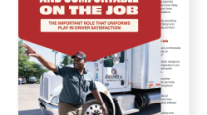Drivers Use Apps, Social Media to Stay Connected With Family, Friends
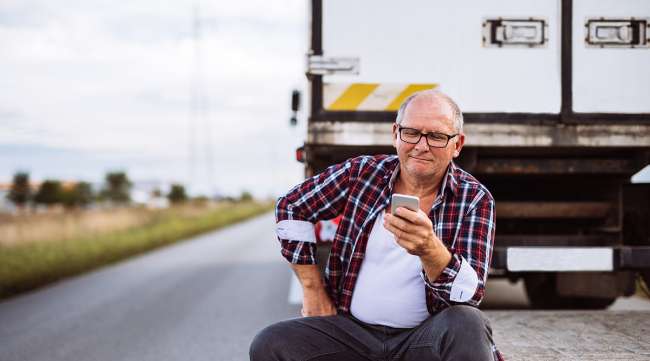
[Stay on top of transportation news: Get TTNews in your inbox.]
As an over-the-road professional driver, Glenna Willis can’t be physically present at her husband’s occupational and speech therapy appointments as he recovers from health issues, but she still can take part in them. Willis, who hauls freight for Tri-State Expedited out of Perrysburg, Ohio, connects with her husband and his therapists via Google Duo, a video chat mobile app, during her 30-minute breaks.
“I have a way to actually see his face and see how he is walking or watch the occupational or physical therapy, so we know what we can do at home,” she said.
This is just one example of how drivers are using modern mobile technology to stay connected with friends and family, which is especially important for longhaul truck drivers, who sometimes spend weeks at a time on the road.

Reymer
“Most drivers don’t go to a job and say, ‘Send me to a place where I’m going to have a difficult time staying connected,’” said Jeremy Reymer, president of DriverReach, a driver recruiting company.
Remaining connected has taken on even greater importance as current events have added to the isolation drivers can feel while on the road.
“Not only are drivers being exposed to the COVID-19 virus on a daily basis as they eat, fuel, deliver and shower away from home, they worry about exposing their families if and when they do get home,” said Ellen Voie, president of Women in Trucking Association. “Now, add protests in major cities to the mix, and a driver’s physical safety is even more vulnerable. Their families need to be reassured that their loved one — a driver — is safe.”
Dan Van Alstine, president of Ruan, said family is a huge priority for many professional drivers.
“A lot of times, drivers will have anxiety about what is going on at home. Right now, kids aren’t at school, and family members might be at risk,” he said. “This is a bizarre time and can feel very different.”
Ruan, based in Des Moines, Iowa, ranks No. 40 on the Transport Topics Top 100 list of the largest for-hire carriers in North America.
Reymer said video calling via applications such as Zoom, Google Meet and Microsoft Teams are popular ways for drivers to communicate with friends and family.
“Video is very personal and engaging,” he said, adding that video calls are the next best thing to connecting in person.
Kim McGinnis, a driver for Fremont Contract Carriers, based in Fremont, Neb., stays in touch with her children, grandkids and great grandkids via family chats on Google Duo.
“Someone will call and everyone joins in. It is so much fun, and you get to see everybody,” she said, adding that they also have a family chat room on Facebook Messenger.
David Broyles, director of driver services for Averitt Express — No. 32 on the for-hire TT100 — said a majority of the company’s drivers use cellphones to stay connected.
“We have a driver service department that calls drivers every day just to check in and see if they are having any issues we can help with,” he said.
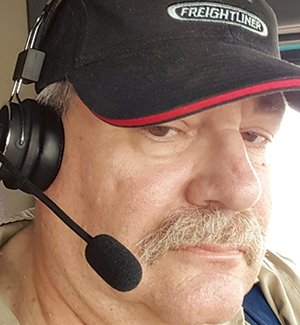
Truck driver Bob Stanton has a morning phone call with his wife every day so they can check in on each other. (Courtesy of Bob Stanton)
Bob Stanton, a professional driver, said the mobile phone has become the modern citizens band (CB) radio. He has a circle of friends that reach out to each other to see who wants to talk.
“We do daisy-chain phone calls. You can add people to the phone call. It is the chitty chat you would have done on a CB, but it is people we know instead of the random truck that happens to be in front of you,” he said. “The challenge is if the person who started the chain leaves, you have to start all over.”
Stanton also has a standing morning phone call with his wife so they can check in with each other. “It is for both of us. If she doesn’t call me back, the kids are going to go check on her. If I don’t answer the call, she has the 24-hour numbers for dispatch, so they can see if it is moving or not,” he said, adding that he shares his location with his wife using Google Maps before he goes to bed at night.
McGinnis shares her location with her family via the Life360 app.
“Everybody knows where I am all the time,” she said.
Social media is another way drivers share location information with others.
Josh Rodriguez, a driver for Grand Island Express, based in Grand Island, Neb., connects with loved ones via social media and posts at least once a day on Facebook and Instagram.
“That way, friends and family can have an idea where I’m at. I can also look back on my Instagram and see every place that I’ve been for the past three years,” he said.
Communication is an important part of drivers’ mental wellness, said Steve Kane, president of Rolling Strong, a provider of health and wellness programs for drivers.

Kane
Rolling Strong’s mobile app features a social media page where drivers can find other friends on the site.
“Once you friend people, you can message back and forth between those new contacts you’ve made,” Kane said. “We built out this whole gamification aspect of our program. You can create head-to-head competition.”
Kane said the app connects drivers who probably didn’t know each other beforehand, and drivers can invite their family members to take part, too.
Averitt, which is based in Cookeville, Tenn., has a closed Facebook group specifically for Averitt drivers that is administered by its driver services group.
“Drivers share information they feel is important on the page and ask questions,” Broyles said. “We average about 900 posts/comments a day.”
Ruan created a proprietary app to connect with drivers and has several programs to help cultivate a sense of belongingness. That can be a text message from a manager or interaction via social media, Van Alstine said.
“You draw upon many, many quivers to really aim at individuals to make sure they feel connected,” he explained. “An important part of our work in this time is keeping drivers healthy physically and mentally.”
Wireless Connectivity on the Road
Drivers said they often rely on their own cell coverage to log onto their devices.
Rodriguez of Grand Island Express uses his phone to create a hotspot for his tablet. He said he prefers that to logging onto truck stops’ Wi-Fi service.
“Sometimes it is only available inside or at certain parts of the truck stop,” he said.
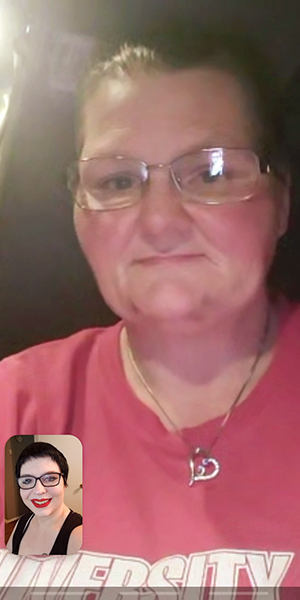
Glenna Willis, a driver for Tri-State Expedited out of Perrysberg, Ohio, connects with her husband's therapists and her family over Google Duo. Here she is chatting with her daughter, Kay Evans. (Courtesy of Glenna Willis)
Willis said she has better luck with truck stops’ Wi-Fi when she is inside the building or restaurant, but she mostly relies on her cell coverage.
Tristen Griffith, president of the Sacramento 49er Truck Stop in Sacramento, Calif., said drivers appreciate free Wi-Fi, which her location offers.
“You’re always on your phone, especially now that you can’t be together in person. There are a couple of dead spots, but for the most part, it works well,” she said.
Barry Richards, president of TravelCenters of America, said the company has Wi-Fi at all of its locations. At select locations, it is free inside, but there is a charge in the parking lot.
“The experience can range from excellent to not-so-desirable. It all depends on the service that is available to us in the area,” he said. “There is a vendor between me and the customer that can affect my reputation.”
About two years ago, TA evaluated its system nationwide, looking for new providers.
“Being a technology-driven product, this changes from month to month, so you have the issue of keeping up with this for some 260 locations,” he said.
TA has focused on outdoor Wi-Fi because drivers want to use it in their cabs to stream movies and communicate with loved ones.
“It is where they relax. It is their home on the road,” Richards said, adding that over the years, the challenge has been with shooting signal over a parking lot that could have 500 trucks in it. “It requires a lot of equipment. It requires maintenance.”
Richards said the company is excited about emergence of 5G wireless connectivity.
“It is supposed to be a much more stable way for people to have coverage across the country and more thorough coverage,” he said.
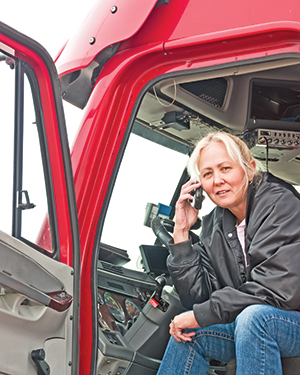
A driver uses her cellphone. Truckers increasingly use Wi-Fi at truck stops to log onto their devices. It can sometimes be spotty in parking lots. (Robert Carner/Getty Images)
Jason Pesek, product manager for KeepTruckin, an electronic logging device provider, said drivers can use the company’s Vehicle Gateway as a Wi-Fi hotspot.
The device plugs directly into the vehicle, so drivers are connected anywhere they go. The Wi-Fi can be used to complete work-related tasks, such as logging hours of service and recording dashcam footage.
Fleet managers can offer the Wi-Fi access to drivers, who can connect to it with any Wi-Fi capable mobile device, and drivers can also purchase more data for themselves. “It’s a great way to lower costs and stay connected on the sometimes isolated remote roads,” Pesek said.
George Koroneos, a spokesman for Verizon, said that “hotspotting” a phone is a good option for those that need periodic access to Wi-Fi. However, an actual hotspot, such as a Verizon MiFi Jetpack, which has cellular service built into it, can provide more functionality and flexibility.

COVID-19 has placed significant strain on many freight networks. So how are third-party logistics providers adapting to meet these challenges? Host Seth Clevenger chats with two 3PL executives who have had firsthand experience contending with this crisis. Hear a snippet, above, and get the full program by going to RoadSigns.TTNews.com.
“You don’t buy your phone for a hotspot. You buy a phone, and it has hotspot capabilities,” he said, adding that Verizon makes 15 GB of data available for phones’ hotspots and, after that, the speed slows.
Customers do have to buy a data plan to support an in-cab hotspot, Koroneos said.
Eight years ago, McGinnis had a separate Wi-Fi device in her truck, but she said that once phones got better, she didn’t need it.
“There is no use to pay the extra price,” she said, adding that her company does not pay for her cellphone.
If companies do offer cellphone reimbursement, it is generally in the form of a stipend, Reymer said.
The Shifting Role of CB Radio
Drivers don’t use CB radios to stay connected as much as they used to, Broyles said.
“The hands-free cellphone has about made that obsolete for communicating with drivers,” he said. “The ones that do use a CB say they use it to listen for issues on the roads.”
Rodriguez said he has never had a CB and hasn’t felt like he needed one.
“If I have time to interact, I’d rather talk to someone I know,” he said. “The one actual use for one would be that you could see if there was a [traffic] backup, you could catch the opposite way they might give you a heads up to what lane to be in.”
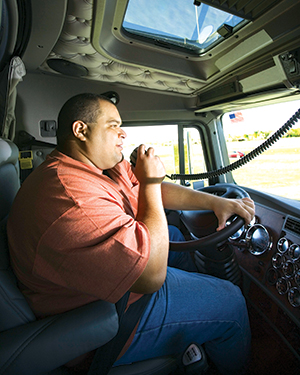
A driver uses his CB radio. They aren't as popular as they used to be, with the numerous ways drivers can now talk directly to friends and family. (Thinkstock Images)
Unlike Rodriguez, McGinnis has always had a CB radio to communicate with people around her. She said it is useful for getting information on accidents and weather, but that there is less chatter on it than there used to be.
“The whole culture with truck drivers is changing,” she said. “It used to be way more active, but now not so much.”
For Stanton, the recent civil unrest has added to his desire to install a CB, and he has added it to his list of things to do.
Ruan allows CBs in trucks, but most drivers don’t care about them.
“It is very much in the minority depending on your age and how long you’ve been in the industry,” Van Alstine said.
Despite the need to connect, Ruan’s Van Alstine said the fleet puts safety first and has a strict policy prohibiting the use of mobile devices while a truck is operating to minimize driver distractions.
Rodriguez said he has a headset and takes hands-free calls from his closest friends and family. However, there are times he can’t chat.
“I don’t want them to think that if they don’t hear from me it is because I don’t want to talk to them. It is that there is a lot I have to think about during the day,” he said.
Want more news? Listen to today's daily briefing:
Subscribe: Apple Podcasts | Spotify | Amazon Alexa | Google Assistant | More


